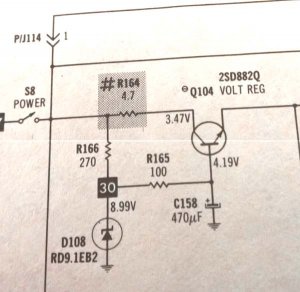Docs, as in the past, I can give you hints and clues, and the actual hands on troubleshooting is up to you.
It sounds like one component, connection or wire is shorted.
Presuming you've already checked Q104 to ensure it's working properly, disconnect emitter of Q104 and check voltages at Q104 as well as D108. With eQ104 disconnected, restore power and see if R164 holds. If yes, then check voltages. If voltages are out of range, then correct the issue before proceeding. You have an issue at the regulator.
If voltages appear proper, then check all of the bypass caps downstream fed by that 3.46v regulator for a short to ground. There are a lot to check but you can check them quickly in circuit simply by using a DMM on the ohms range across the cap leads. Before checking, it is a good idea to discharge any caps that will be tested by jumping the 2 leads for a moment. This provents potential damage to your meter by residual charge on the caps. Any caps that are in series with a good working resistor is probably, for the purposes of this test, not the likely culprit. You should not read low ohms across any of the caps. This is the easy part. It goes without saying that when checking circuits using the ohms function, first DISCONNECT the power. You are NOT taking resistance measurements live.
If all caps test good, then any circuit downstream should be checked for short. Using schematics, highlight any circuits fed by that regulator. From there, check each sub circuit to see if any of the transistors, caps or resistors are shorted. Generally speaking, any circuit in series with and downstream to a resistor that has tested good is probably safe to presume not culpable unless the resistor is low ohms. The reason is that R164 is only 4.7R. Therefore, a circuit downstream that runs through a good 100R resistor will not draw enough current to toast R164. This clue shall allow you to isolate and eliminate possible paths as likely good.
Good luck.
BTW, is that schem one that I sent to you? If so, please respect our prior agreements not to share, especially hi-res examples.


